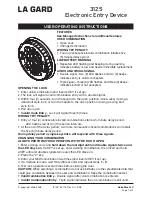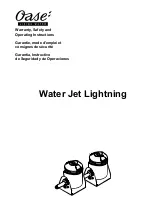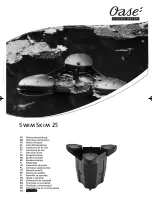
22
5
INSTALLATION
The speaker systems can be placed as desired.
•
The location must be solid, plane, anti-slip, vibration-free, oscillation-free, and fire-resistant. The installation area
must hold a minimum point load of 5 times the system's load (e.g. weight 20 kg - point load 100 kg). The
speakers must never be installed higher than 100 cm without secondary attachment.
•
This speaker system may only be installed on top of another speaker system if both systems are lashed up with
each other via appropriate clamping belts and protected against flipping over.
•
Always install the speaker systems in a way that a minimum distance of three meters to the audience is kept.
This is the only way to avoid hearing damage for unreasonable listeners. Block the area in front of the speaker
systems with appropriate means.
•
Extreme levels like feedback, bass-hum or the beats of a dropping microphone can destroy the loudspeakers
within very short time and produce immediate hearing damage. Such extreme levels must be avoided at any
rate. We recommend using appropriate equalizers and compressors/limiters.
•
For transport, the speaker systems feature two carrying handles. The speaker system should be carried without
force by two persons of the same size. Carrying the speaker system as one person alone should be avoided as
the high weight and the strain could lead to back damages and torsions. Please note that all speaker systems
with more than 25 kg weight must be transported with two persons. Models VFM-215A and VFM-215AP feature
two wheels for
convenient transport.
Stands
It is possible to put the speaker systems onto a PA speaker stand via the stand flange on the lower side.
•
Stands must only be installed on a plane area with a maximum inclination angle of 5°.
•
When using stands or satellite systems under the influence of horizontal forces, e.g. through wind, the standing
safety can be impaired. This is why additional safety measures like attaching ballast weights have to be taken.
•
If inclined tension cables or prolonged outriggers are used, the area of danger has to be marked or even be
blocked.
•
Before lifting or lowering the telescopic tubes, you must always block a safety area around the stand or satellite
system. This safety area must have a diameter of 1.5 times the maximum height.
•
Lifted telescopic tubes always have to be secured with a secondary securing!
•
The total weight of the installation (=total weight of all individual parts) must never exceed the maximum load of
the installation area.
•
The stand has to be installed out of the reach of people.
•
An unintended movement of the load has to be avoided - also in case of fire!
•
The installer is responsible for adhering to the carrying capacity given by the manufacturer, the safety
requirements and the qualification of possible co-workers.
•
When people are located below the load, all necessary safety measures have to be taken in order to avoid injury.
•
The personnel have to be instructed on the content of the user manual and on the dangers related with operating
stands.
•
Depending upon the individual installation spot, all necessary measures against movement and for securing the
standing safety have to be created.
•
The installation is only allowed on carrying areas. In some cases, an appropriate substructure, e.g. via a
balancing foot, has to be created. When choosing the installation material, optimum dimensions have to be
chosen in order to secure maximum safety.
•
Speaker systems installed on stands or satellite systems may cause severe injuries when crashing! If installing
on slippery surfaces, the legs must be secured with screws or nails via the provided holes or an anti-slippery mat
has to be used.
Satellite Systems
It is possible to mount the speaker systems on top of a subwoofer system. For this, insert a distance tube of 35
mm (accessory) into the flange on the upper side of the subwoofer; then fasten the speaker system on top.
•
The speakers have to be installed out of the reach of people. An unintended movement of the load has to be
avoided - also in case of fire!
•
The installation is only allowed on carrying areas. In some cases, an appropriate substructure, e.g. via a
balancing foot, has to be created.
•
Depending upon the individual installation spot, all necessary measures against movement and for securing the
standing safety have to be taken.







































